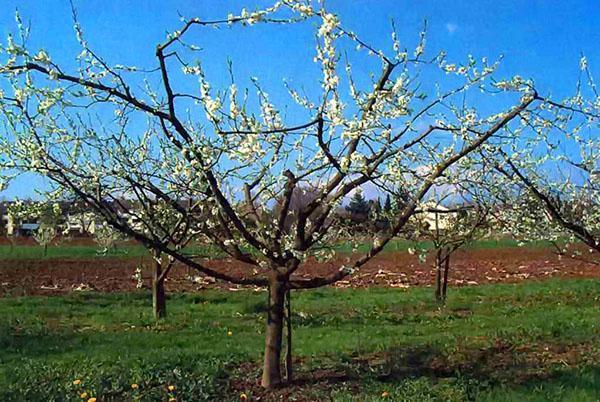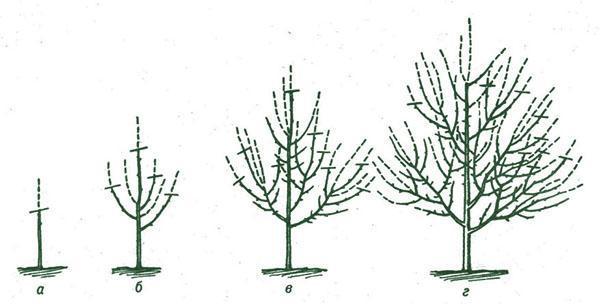Why and when pruning of plums is carried out
 Pruning plums is an essential part of caring for a fruit crop. If pruning is neglected, the spontaneous growth of the crown will not only negatively affect the appearance of the tree, but also lead to a deterioration in the quality and volume of the crop.
Pruning plums is an essential part of caring for a fruit crop. If pruning is neglected, the spontaneous growth of the crown will not only negatively affect the appearance of the tree, but also lead to a deterioration in the quality and volume of the crop.
Pruning plums in the first years after planting
Regular crown formation begins almost immediately after planting. Then, sanitary pruning and rejuvenation of already adult, fruiting plants is added to these works.
In order for the crown of the tree to be as compact as possible, strong, easily permeable to air, light and pollinating insects, formative pruning of plums is carried out from the first year after planting. To achieve the set goals helps:
- removal of shoots directed deep into the crown and leading to its excessive density;
- correction of the position of shoots extending from the trunk at too sharp an angle;
- removal of weak branches;
- setting of strong, evenly spaced skeletal branches with good growth and fruiting prospects.
Young trees are pruned very carefully with an eye to the future. How to trim plum at this time the diagram will prompt:
When the tree enters the fruiting season, crown formation does not end, but stops for 2-3 years. During this period, the plant has time to acquire a new growth, on which the first harvests will be laid.
This garden requires supportive pruning to help it grow while providing a decent amount of fruit.
Pruning a fruiting plum tree
The younger the tree, the stronger the annual growth. With age and the beginning of fruiting, the growth rate of the crown decreases. From 30-40 cm, the growth falls to 15 cm, which indicates the need for rejuvenation. This pruning of plums is done in order to maintain growth and yield. If the gardener does not pay attention to this procedure:
- even a properly formed crown thickens over time;
- ovary formation goes to the very periphery;
- fruits that do not receive nutrition and moisture become smaller;
- the quality of the crop and its volume are deteriorating.
The neglected trees not only bear less fruit every year, they become accessible prey for pests and diseases of fruit crops.
 The first thing to do with anti-aging pruning is thinning the crown and removing damaged branches. If there is a large amount of work, it is better to carry out them in stages.
The first thing to do with anti-aging pruning is thinning the crown and removing damaged branches. If there is a large amount of work, it is better to carry out them in stages.
- First, the most thawed, withered or heavily damaged branches, root growth, as well as shoots growing inside the crown are cut out.
- The next year, the crown is subject to thinning, while the young shoots formed during this time are left and, if necessary, shortened.
After the pruning of the plum is completed, the cuts with a diameter of more than 1–2 cm should be treated with pitch, and the tree should be fed and watered.
 The renewed plum gives a powerful growth, some of which will become new skeletal branches. The rest of the shoots should be cut into a ring. Tall varieties of plums can grow up to 8-10 meters. Therefore, together with anti-aging pruning, their height is corrected.
The renewed plum gives a powerful growth, some of which will become new skeletal branches. The rest of the shoots should be cut into a ring. Tall varieties of plums can grow up to 8-10 meters. Therefore, together with anti-aging pruning, their height is corrected.
Pruning plums in spring
 Spring brings a lot of joy and trouble. Plums come to life earlier than other fruit trees and begin growing, so it is important to prune them on time. The formation of the crown of young plants should take place 20 - 30 days before bud break, that is, until the tree is out of dormancy. This will stimulate the rapid growth of the shoots and will not weaken the green pet.
Spring brings a lot of joy and trouble. Plums come to life earlier than other fruit trees and begin growing, so it is important to prune them on time. The formation of the crown of young plants should take place 20 - 30 days before bud break, that is, until the tree is out of dormancy. This will stimulate the rapid growth of the shoots and will not weaken the green pet.
There are no restrictions on pruning mature plum trees. Work can be carried out from early spring to late autumn, if weather conditions permit. This mainly concerns the sanitary cutting of dry and diseased parts of the tree.
If rejuvenation is to be done, as in the case of a young seedling, it is better to finish pruning the plum in spring 20 days before the buds swell.
Pruning plums in summer
 Summer is the most active and difficult season of the year for fruit tree... At this time, it forms an ovary and actively feeds to give a bountiful sweet harvest.
Summer is the most active and difficult season of the year for fruit tree... At this time, it forms an ovary and actively feeds to give a bountiful sweet harvest.
Can the plum be trimmed at this time? Wouldn't such interference by a gardener be harmful? Of course, from April to September, you should not engage in crown formation or rejuvenate the orchard. But even in the warm season, there is a case for a hacksaw, garden shears and pruning shears.
Pruning plums in summer aims to maintain proper growth and redirect nutrients from waste to branches and fruits.
To do this, throughout the summer, it is necessary to cut out the green tops and all root shoots so that there are no protruding hemp on the trunk and just below the ground level.
 Pruning plums in autumn is acceptable in regions where autumn is long and fruit trees have enough time to acclimatize and not suffer from severe frosts. Most often, this agricultural technique is practiced south of the middle lane. However, cutting out dry branches or diseased branches can and should be carried out in the autumn months. Fallen foliage does not interfere with assessing the situation, so that by spring the tree comes up completely ready for flowering and fruiting.
Pruning plums in autumn is acceptable in regions where autumn is long and fruit trees have enough time to acclimatize and not suffer from severe frosts. Most often, this agricultural technique is practiced south of the middle lane. However, cutting out dry branches or diseased branches can and should be carried out in the autumn months. Fallen foliage does not interfere with assessing the situation, so that by spring the tree comes up completely ready for flowering and fruiting.